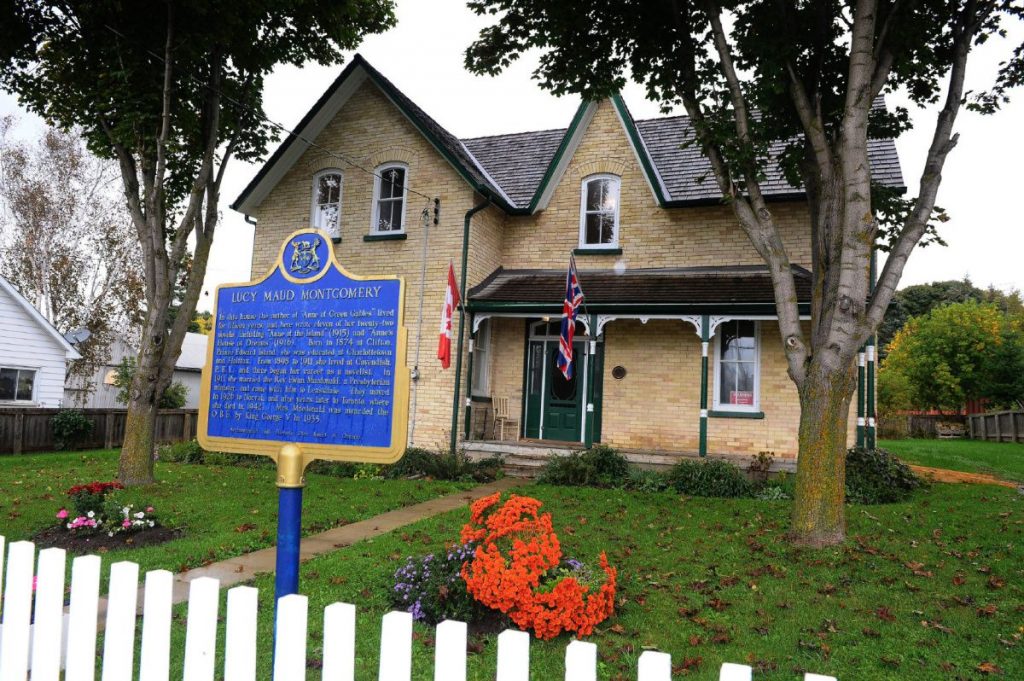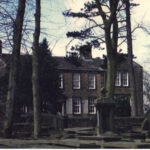Blog Post
Discovering the Ontario homestead where the life of Anne of Green Gables was created
This is Part II of my two-part series on literary locations across Canada. Part I can be found here.
L.M. Montgomery’s Home in Leaksdale, Ontario
My wife is an obsessive fan of Anne of Green Gables, the melodramatic and mischievous redhead from the Maritimes that has successfully captured the hearts of millions. Several years ago, I was hunting for some place to go with her on a day-trip, and stumbled across a place I didn’t know existed: The home of L.M. Montgmery in Leaksdale, where it turns out she wrote most of the Anne books. Like most others, I thought that a trip to Prince Edward Island was necessary in order to visit a place associated with Anne Shirley and her creator, but it was actually a little house in the forested countryside of Leaksdale (just north of Toronto), a brief walk down the road from the Presbyterian church that her husband pastored, that is the birthplace of many of Montgomery’s works.
For those interested in Montgomery and the immortal characters she created, I cannot recommend a trip to Leaksdale more highly. You can enter the old church where her husband preached and sit in her pew. Just outside the church is a statue of Montgomery, sitting on a bench with a smile playing about her lips—perhaps she had just thought of the next story she wanted to tell. Inside the house, the friendly tour guide let us sit on the couch where Montgomery did her writing, and even let my wife play her ancient organ. Directly across the muddy road from the Montgomery house was a little green valley, crested by flaming trees garbed in all of autumn’s orange and crimson glory. This place, the guide told us, was the inspiration for Montgomery’s Rainbow Valley. I went back later to find her description of the place: “The sun was setting over Rainbow Valley. The pond was wearing a wonderful tissue of purple and gold and green and crimson. A faint blue haze rested on the eastern hill, over which a great, pale, round moon was just floating up like a silver bubble.” It is all still there.
Montgomery could capture Canada’s natural beauty like few other writers could—and as someone who grappled with depression, she could also grasp its healing power. “It was November,” she wrote in one of her Anne books, “the month of crimson sunsets, parting birds, deep, sad hymns of the sea, passionate wind-songs in the pines. Anne roamed through the pineland alleys in the park and, as she said, let that great sweeping wind blow the fogs out of her soul.” To walk the same paths and see just what Montgomery saw, and then to read those lines—that is the way to fall in love with literature. Montgomery’s pages fairly breathe with the crisp breezes that caressed her upturned face, passed through her pen, and now refresh generations of readers.
But I believe it is the nostalgia that Montgomery captures that truly explains the ever-green nature of her storytelling. Anne’s journey from a little girl enraptured by the high drama of ordinary living through the perils of adolescence and culminating in the arrival of adulthood and, eventually, her own children—Montgomery tells this story in a way that can catch you off-guard, as if someone had reminded you suddenly how much time had passed and how many beautiful moments turned into memories before you had a chance to notice. Like in Anne of the Island, when the grown-up Anne Shirley looks at her bosom friend Diana, who has just become a mother—and is suddenly struck by how much time had slipped away, and how much it had taken with it: “Could this pale woman with the rapture in her eyes be the little black-curled, rosy-cheeked Diana she had played with in vanished schooldays? It gave her a queer, desolate feeling that she herself somehow belonged only in those past years and had no business in the present at all.”
Who cannot understand those few lines? Who has not flipped through an old photo album, looked up, and realized suddenly how many people have come and gone and changed and grown and thought with a sharp pang that isn’t quite pain but rather feels like it, that although we might not really want to go back in time, we still find ourselves desperately wishing we could crawl inside of one of those old memories and be there for just a moment, and feel all of those same feelings once again? That is nostalgia—the realization that the moment we are living in, right now, will probably be one of the “good old days” in just a moment or two—and few writers can render the contradiction of that sense of sadly happy remembrance as well as Lucy Maud Montgomery.
Winnie-the-Bear Statue in Assiniboine Park, Winnipeg, Manitoba
Earlier this year on a brief stopover in Winnipeg, I headed with a friend to Assiniboine Park, where the Pavilion hosts a permanent Pooh Gallery featuring many of Lieutenant Harry Coleburn’s original photographs of “the real Winnie the Bear,” Coleburn’s diaries, some documents, and even a handwritten letter by Christopher Robin Milne—the real Christopher Robin. A short walk from the Pavilion, a plaque next to a statue of Winnie as a bear cub, dedicated to “the children of the world” by sculptor William Epp in 1992, tells the story:
On August 24, 1914, while en route overseas during World War I, Lieutenant Harry Coleburn, V.S., of the 34 Fort Gary horse regiment of Manitoba, purchased a black Canadian bear cub at White River, Ontario. He named her Winnie, after Winnipeg, his home town. The bear became the pet of the soldiers. While Lieutenant Coleburn served in France, she was left in the care of the London Zoo. In 1919, he gave her to the zoo where she was visited and loved by many, including the author A.A. Milne and his son Christopher.
In 1920, A.A. Milne gave the fictional character Winnie the Pooh, named after Lieutenant Coleburn’s bear, to Christopher Robin and his friends for posterity. Winnie died at the London Zoo on May 12, 1934.
Anyone who has read A.A. Milne’s books—Winnie the Pooh, The House at Pooh Corner, When We Were Very Young, and Now We Are Six—knows that they are, simply put, a treasure. Very few books manage to be whimsical, truthful, and yet so funny that even the chapter titles can make you laugh out loud. A.A. Milne’s fantasy world, located in the forest behind his countryside house (the Hundred Acre Wood) and inhabited by his son Christopher Robin and his stuffed animals, is one so precious to so many that England has actually attempted to get the Milne’s original toys back from the New York Public Library where they are on permanent display, claiming that they are a “national treasure.” For a country that had been so recently ravaged by the First World War, Milne was the storyteller they needed: He taught them how to laugh again.
Milne also captured that sad, poignant moment when one is just old enough to realize that he is leaving childhood behind, but isn’t quite sure that he wants to. His description of Christopher Robin’s farewell to Pooh as he tries to explain to the bear that he must go off to school, grow up, and become an adult—that he can no longer enjoy doing their favorite thing (“Nothing”)—are some of the most beautiful lines in children’s literature:
Then, suddenly again, Christopher Robin, who was still looking at the world, with his chin in his hands, called out “Pooh!”
“Yes?” said Pooh.
“When I’m—when—Pooh!”
“Yes, Christopher Robin?”
“I’m not going to do Nothing any more.”
“Never again?”
“Well, not so much. They don’t let you.”
Pooh waited for him to go on, but he was silent again. “Yes, Christopher Robin?” said Pooh helpfully.
“Pooh, when I’m—you know—when I’m not doing Nothing, will you come up here sometimes?”
“Just me?”
“Yes, Pooh.”
“Will you be here too?”
“Yes, Pooh, I will be, really. I promise I will be, Pooh.”
“That’s good,” said Pooh.
“Pooh, promise you won’t forget about me, ever. Not even when I’m a hundred.”
Pooh thought for a little. “How old shall I be then?”
“Ninety-nine.”
Pooh nodded. “I promise,” he said.
Still with his eyes on the world Christopher Robin put out a hand and felt for Pooh’s paw. “Pooh,” said Christopher Robin earnestly, “if I—if I’m not quite—” he stopped and tried again—”Pooh, whatever happens, you will understand, won’t you?”
“Understand what?”
“Oh, nothing.” He laughed and jumped to his feet. “Come on!”
“Where?” said Pooh.
“Anywhere,” said Christopher Robin.
So they went off together. But wherever they go, and whatever happens to them on the way, in that enchanted place on the top of the Forest, a little boy and his Bear will always be playing.
It is fitting that the statue of Winnie the Bear stands in the middle of a playground, constantly surrounded by children who, like Christopher Robin, are filling their beautiful sunny days with Nothing. Because after the wonder of childhood—if you are blessed to have such a thing—comes the rest of life, which is far less simple. So it was for Christopher Robin Milne, too, who was brutally bullied throughout his boarding school days because of the childhood his father had immortalized in the wildly famous Winnie the Pooh books. It was something that he only made peace with upon the arrival of his own daughter, a little girl with cerebral palsy named Clare Milne, who would receive the endless love and devotion of her father Christopher Robin–who, after all, understood what childhood was all about.








